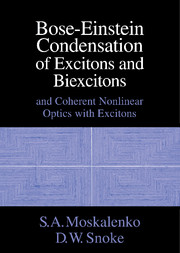Book contents
- Frontmatter
- Contents
- Preface
- 1 Introduction
- 2 Basic Theory of Bose–Einstein Condensation of Excitons
- 3 The Interaction of Condensed Excitons with Lattice Phonons
- 4 Bose–Einstein Condensation of Biexcitons
- 5 Phase Transitions and Thermodynamics of High-Density of Excitons
- 6 The Optical Stark Effect and the Virtual Bose Condensate
- 7 Bose–Einstein Condensation of Mixed States of Excitons and Photons
- 8 Nonequilibrium Kinetics of High-Density Excitons
- 9 Coherent Nonlinear Optics with Excitons
- 10 New Directions
- Appendix A: Properties of Excitons in Cu2O
- Author Index
- Subject Index
3 - The Interaction of Condensed Excitons with Lattice Phonons
Published online by Cambridge University Press: 04 August 2010
- Frontmatter
- Contents
- Preface
- 1 Introduction
- 2 Basic Theory of Bose–Einstein Condensation of Excitons
- 3 The Interaction of Condensed Excitons with Lattice Phonons
- 4 Bose–Einstein Condensation of Biexcitons
- 5 Phase Transitions and Thermodynamics of High-Density of Excitons
- 6 The Optical Stark Effect and the Virtual Bose Condensate
- 7 Bose–Einstein Condensation of Mixed States of Excitons and Photons
- 8 Nonequilibrium Kinetics of High-Density Excitons
- 9 Coherent Nonlinear Optics with Excitons
- 10 New Directions
- Appendix A: Properties of Excitons in Cu2O
- Author Index
- Subject Index
Summary
Introduction
In this chapter we generalize the theory of the weakly nonideal Bose gas to the case of the interaction of excitons with acoustic or optical phonons, i.e., in the case of interaction with another Bose subsystem, the quasiparticle number of which is not conserved. To simplify the question, we assume that the exciton-phonon interaction leads to only intraband exciton scattering and does not change the total number of excitons in the band. In other words, we consider an isolated exciton band or suppose that the processes of interband scattering are not important because of the symmetries of the exciton and the phonon states and the values of the interaction constants.
The theory of the interaction of condensed excitons with phonons has primary importance in the question of whether excitons will be superfluid. In Chapter 2, we saw that the fact that the excitons are particle-antiparticle pairs does not prevent them from becoming superfluid. At first glance, however, it is not easy to draw an analogy to other Bose condensates such as liquid He. In the case of liquid He, interactions with the external world are limited to the surfaces of the container, while for excitons, the phonon field interpenetrates the same region of space as the exciton gas. The situation is more analogous to the case of a superconductor. Unlike a BCS superconductor, however, in an exciton condensate the lattice phonons have nothing to do with the pairing. We shall see that nevertheless the excitonic condensate remains superfluid in the presence of a phonon field. At the end of this chapter we review recent experiments that may be evidence of excitonic superfluidity.
- Type
- Chapter
- Information
- Bose-Einstein Condensation of Excitons and BiexcitonsAnd Coherent Nonlinear Optics with Excitons, pp. 82 - 122Publisher: Cambridge University PressPrint publication year: 2000



